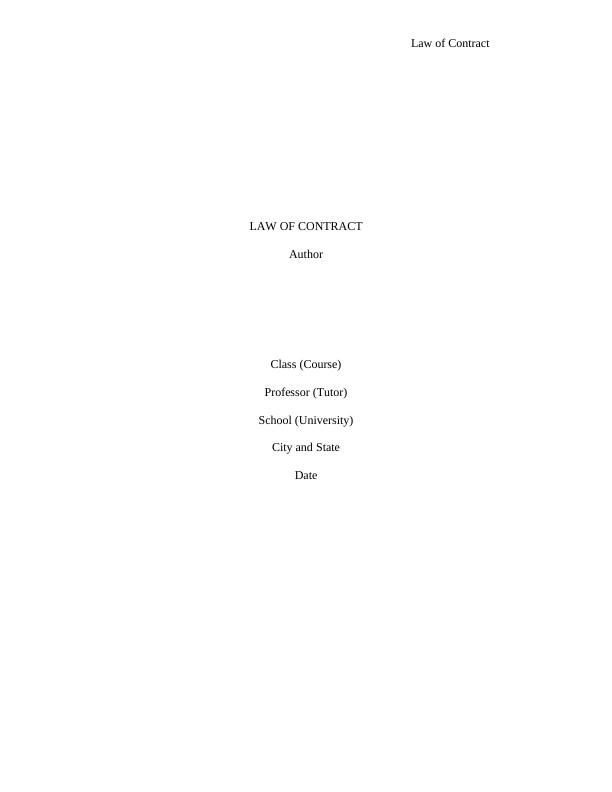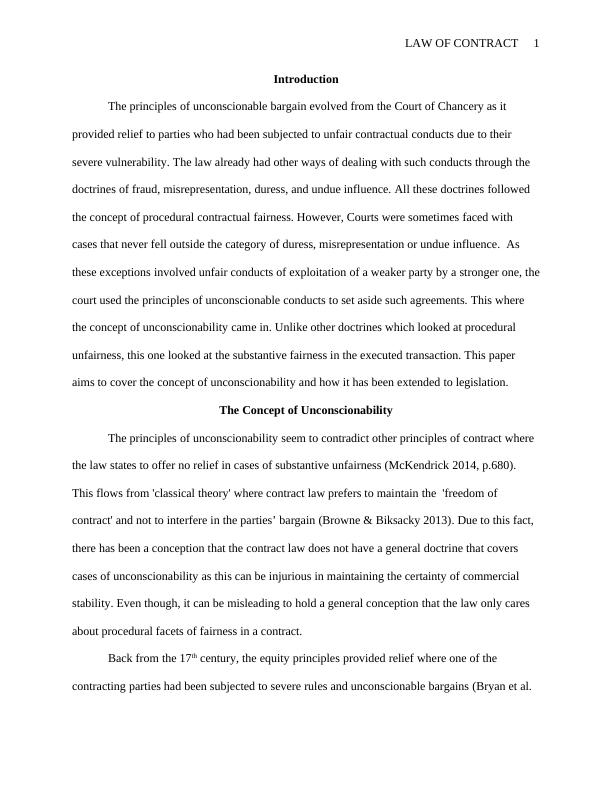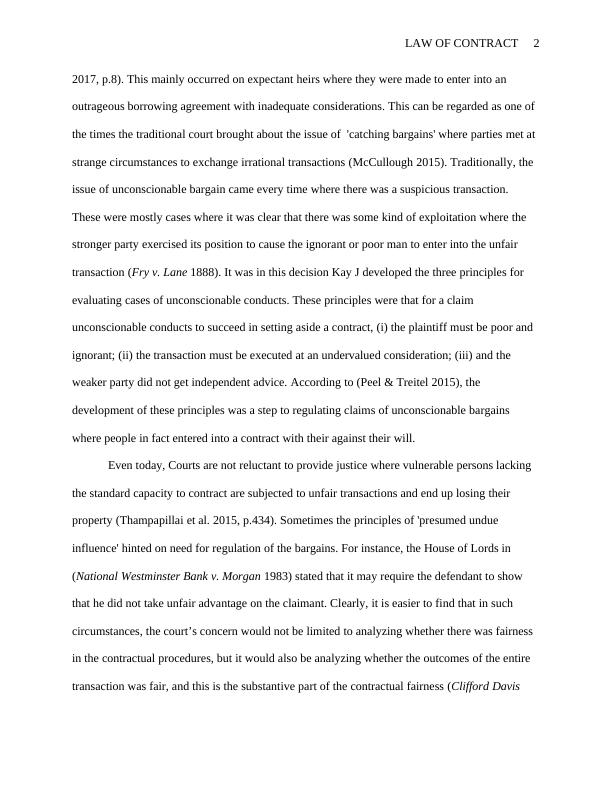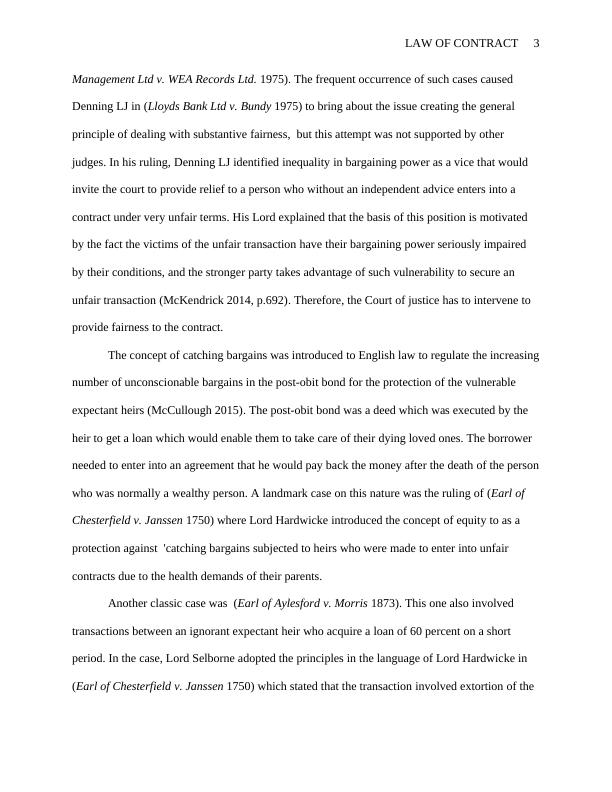Unconscionable Bargain: Principles and Legislation
Added on 2023-01-20
13 Pages4141 Words83 Views
Law of Contract
LAW OF CONTRACT
Author
Class (Course)
Professor (Tutor)
School (University)
City and State
Date
LAW OF CONTRACT
Author
Class (Course)
Professor (Tutor)
School (University)
City and State
Date

LAW OF CONTRACT 1
Introduction
The principles of unconscionable bargain evolved from the Court of Chancery as it
provided relief to parties who had been subjected to unfair contractual conducts due to their
severe vulnerability. The law already had other ways of dealing with such conducts through the
doctrines of fraud, misrepresentation, duress, and undue influence. All these doctrines followed
the concept of procedural contractual fairness. However, Courts were sometimes faced with
cases that never fell outside the category of duress, misrepresentation or undue influence. As
these exceptions involved unfair conducts of exploitation of a weaker party by a stronger one, the
court used the principles of unconscionable conducts to set aside such agreements. This where
the concept of unconscionability came in. Unlike other doctrines which looked at procedural
unfairness, this one looked at the substantive fairness in the executed transaction. This paper
aims to cover the concept of unconscionability and how it has been extended to legislation.
The Concept of Unconscionability
The principles of unconscionability seem to contradict other principles of contract where
the law states to offer no relief in cases of substantive unfairness (McKendrick 2014, p.680).
This flows from 'classical theory' where contract law prefers to maintain the 'freedom of
contract' and not to interfere in the parties’ bargain (Browne & Biksacky 2013). Due to this fact,
there has been a conception that the contract law does not have a general doctrine that covers
cases of unconscionability as this can be injurious in maintaining the certainty of commercial
stability. Even though, it can be misleading to hold a general conception that the law only cares
about procedural facets of fairness in a contract.
Back from the 17th century, the equity principles provided relief where one of the
contracting parties had been subjected to severe rules and unconscionable bargains (Bryan et al.
Introduction
The principles of unconscionable bargain evolved from the Court of Chancery as it
provided relief to parties who had been subjected to unfair contractual conducts due to their
severe vulnerability. The law already had other ways of dealing with such conducts through the
doctrines of fraud, misrepresentation, duress, and undue influence. All these doctrines followed
the concept of procedural contractual fairness. However, Courts were sometimes faced with
cases that never fell outside the category of duress, misrepresentation or undue influence. As
these exceptions involved unfair conducts of exploitation of a weaker party by a stronger one, the
court used the principles of unconscionable conducts to set aside such agreements. This where
the concept of unconscionability came in. Unlike other doctrines which looked at procedural
unfairness, this one looked at the substantive fairness in the executed transaction. This paper
aims to cover the concept of unconscionability and how it has been extended to legislation.
The Concept of Unconscionability
The principles of unconscionability seem to contradict other principles of contract where
the law states to offer no relief in cases of substantive unfairness (McKendrick 2014, p.680).
This flows from 'classical theory' where contract law prefers to maintain the 'freedom of
contract' and not to interfere in the parties’ bargain (Browne & Biksacky 2013). Due to this fact,
there has been a conception that the contract law does not have a general doctrine that covers
cases of unconscionability as this can be injurious in maintaining the certainty of commercial
stability. Even though, it can be misleading to hold a general conception that the law only cares
about procedural facets of fairness in a contract.
Back from the 17th century, the equity principles provided relief where one of the
contracting parties had been subjected to severe rules and unconscionable bargains (Bryan et al.

LAW OF CONTRACT 2
2017, p.8). This mainly occurred on expectant heirs where they were made to enter into an
outrageous borrowing agreement with inadequate considerations. This can be regarded as one of
the times the traditional court brought about the issue of 'catching bargains' where parties met at
strange circumstances to exchange irrational transactions (McCullough 2015). Traditionally, the
issue of unconscionable bargain came every time where there was a suspicious transaction.
These were mostly cases where it was clear that there was some kind of exploitation where the
stronger party exercised its position to cause the ignorant or poor man to enter into the unfair
transaction (Fry v. Lane 1888). It was in this decision Kay J developed the three principles for
evaluating cases of unconscionable conducts. These principles were that for a claim
unconscionable conducts to succeed in setting aside a contract, (i) the plaintiff must be poor and
ignorant; (ii) the transaction must be executed at an undervalued consideration; (iii) and the
weaker party did not get independent advice. According to (Peel & Treitel 2015), the
development of these principles was a step to regulating claims of unconscionable bargains
where people in fact entered into a contract with their against their will.
Even today, Courts are not reluctant to provide justice where vulnerable persons lacking
the standard capacity to contract are subjected to unfair transactions and end up losing their
property (Thampapillai et al. 2015, p.434). Sometimes the principles of 'presumed undue
influence' hinted on need for regulation of the bargains. For instance, the House of Lords in
(National Westminster Bank v. Morgan 1983) stated that it may require the defendant to show
that he did not take unfair advantage on the claimant. Clearly, it is easier to find that in such
circumstances, the court’s concern would not be limited to analyzing whether there was fairness
in the contractual procedures, but it would also be analyzing whether the outcomes of the entire
transaction was fair, and this is the substantive part of the contractual fairness (Clifford Davis
2017, p.8). This mainly occurred on expectant heirs where they were made to enter into an
outrageous borrowing agreement with inadequate considerations. This can be regarded as one of
the times the traditional court brought about the issue of 'catching bargains' where parties met at
strange circumstances to exchange irrational transactions (McCullough 2015). Traditionally, the
issue of unconscionable bargain came every time where there was a suspicious transaction.
These were mostly cases where it was clear that there was some kind of exploitation where the
stronger party exercised its position to cause the ignorant or poor man to enter into the unfair
transaction (Fry v. Lane 1888). It was in this decision Kay J developed the three principles for
evaluating cases of unconscionable conducts. These principles were that for a claim
unconscionable conducts to succeed in setting aside a contract, (i) the plaintiff must be poor and
ignorant; (ii) the transaction must be executed at an undervalued consideration; (iii) and the
weaker party did not get independent advice. According to (Peel & Treitel 2015), the
development of these principles was a step to regulating claims of unconscionable bargains
where people in fact entered into a contract with their against their will.
Even today, Courts are not reluctant to provide justice where vulnerable persons lacking
the standard capacity to contract are subjected to unfair transactions and end up losing their
property (Thampapillai et al. 2015, p.434). Sometimes the principles of 'presumed undue
influence' hinted on need for regulation of the bargains. For instance, the House of Lords in
(National Westminster Bank v. Morgan 1983) stated that it may require the defendant to show
that he did not take unfair advantage on the claimant. Clearly, it is easier to find that in such
circumstances, the court’s concern would not be limited to analyzing whether there was fairness
in the contractual procedures, but it would also be analyzing whether the outcomes of the entire
transaction was fair, and this is the substantive part of the contractual fairness (Clifford Davis

LAW OF CONTRACT 3
Management Ltd v. WEA Records Ltd. 1975). The frequent occurrence of such cases caused
Denning LJ in (Lloyds Bank Ltd v. Bundy 1975) to bring about the issue creating the general
principle of dealing with substantive fairness, but this attempt was not supported by other
judges. In his ruling, Denning LJ identified inequality in bargaining power as a vice that would
invite the court to provide relief to a person who without an independent advice enters into a
contract under very unfair terms. His Lord explained that the basis of this position is motivated
by the fact the victims of the unfair transaction have their bargaining power seriously impaired
by their conditions, and the stronger party takes advantage of such vulnerability to secure an
unfair transaction (McKendrick 2014, p.692). Therefore, the Court of justice has to intervene to
provide fairness to the contract.
The concept of catching bargains was introduced to English law to regulate the increasing
number of unconscionable bargains in the post-obit bond for the protection of the vulnerable
expectant heirs (McCullough 2015). The post-obit bond was a deed which was executed by the
heir to get a loan which would enable them to take care of their dying loved ones. The borrower
needed to enter into an agreement that he would pay back the money after the death of the person
who was normally a wealthy person. A landmark case on this nature was the ruling of (Earl of
Chesterfield v. Janssen 1750) where Lord Hardwicke introduced the concept of equity to as a
protection against 'catching bargains subjected to heirs who were made to enter into unfair
contracts due to the health demands of their parents.
Another classic case was (Earl of Aylesford v. Morris 1873). This one also involved
transactions between an ignorant expectant heir who acquire a loan of 60 percent on a short
period. In the case, Lord Selborne adopted the principles in the language of Lord Hardwicke in
(Earl of Chesterfield v. Janssen 1750) which stated that the transaction involved extortion of the
Management Ltd v. WEA Records Ltd. 1975). The frequent occurrence of such cases caused
Denning LJ in (Lloyds Bank Ltd v. Bundy 1975) to bring about the issue creating the general
principle of dealing with substantive fairness, but this attempt was not supported by other
judges. In his ruling, Denning LJ identified inequality in bargaining power as a vice that would
invite the court to provide relief to a person who without an independent advice enters into a
contract under very unfair terms. His Lord explained that the basis of this position is motivated
by the fact the victims of the unfair transaction have their bargaining power seriously impaired
by their conditions, and the stronger party takes advantage of such vulnerability to secure an
unfair transaction (McKendrick 2014, p.692). Therefore, the Court of justice has to intervene to
provide fairness to the contract.
The concept of catching bargains was introduced to English law to regulate the increasing
number of unconscionable bargains in the post-obit bond for the protection of the vulnerable
expectant heirs (McCullough 2015). The post-obit bond was a deed which was executed by the
heir to get a loan which would enable them to take care of their dying loved ones. The borrower
needed to enter into an agreement that he would pay back the money after the death of the person
who was normally a wealthy person. A landmark case on this nature was the ruling of (Earl of
Chesterfield v. Janssen 1750) where Lord Hardwicke introduced the concept of equity to as a
protection against 'catching bargains subjected to heirs who were made to enter into unfair
contracts due to the health demands of their parents.
Another classic case was (Earl of Aylesford v. Morris 1873). This one also involved
transactions between an ignorant expectant heir who acquire a loan of 60 percent on a short
period. In the case, Lord Selborne adopted the principles in the language of Lord Hardwicke in
(Earl of Chesterfield v. Janssen 1750) which stated that the transaction involved extortion of the

End of preview
Want to access all the pages? Upload your documents or become a member.
Related Documents
Duress, Undue influence and Unconscionability of Contractslg...
|12
|3547
|92
Unconscionable Conducts in The Contractslg...
|12
|3463
|53
Unconscionable Conduct and Misrepresentation in Contract Lawlg...
|8
|2229
|411
(pdf) General principles of contractlg...
|13
|3612
|82
Business and Corporation Lawlg...
|9
|2609
|123
Business Law Assignment Unconscionabilitylg...
|10
|2643
|83